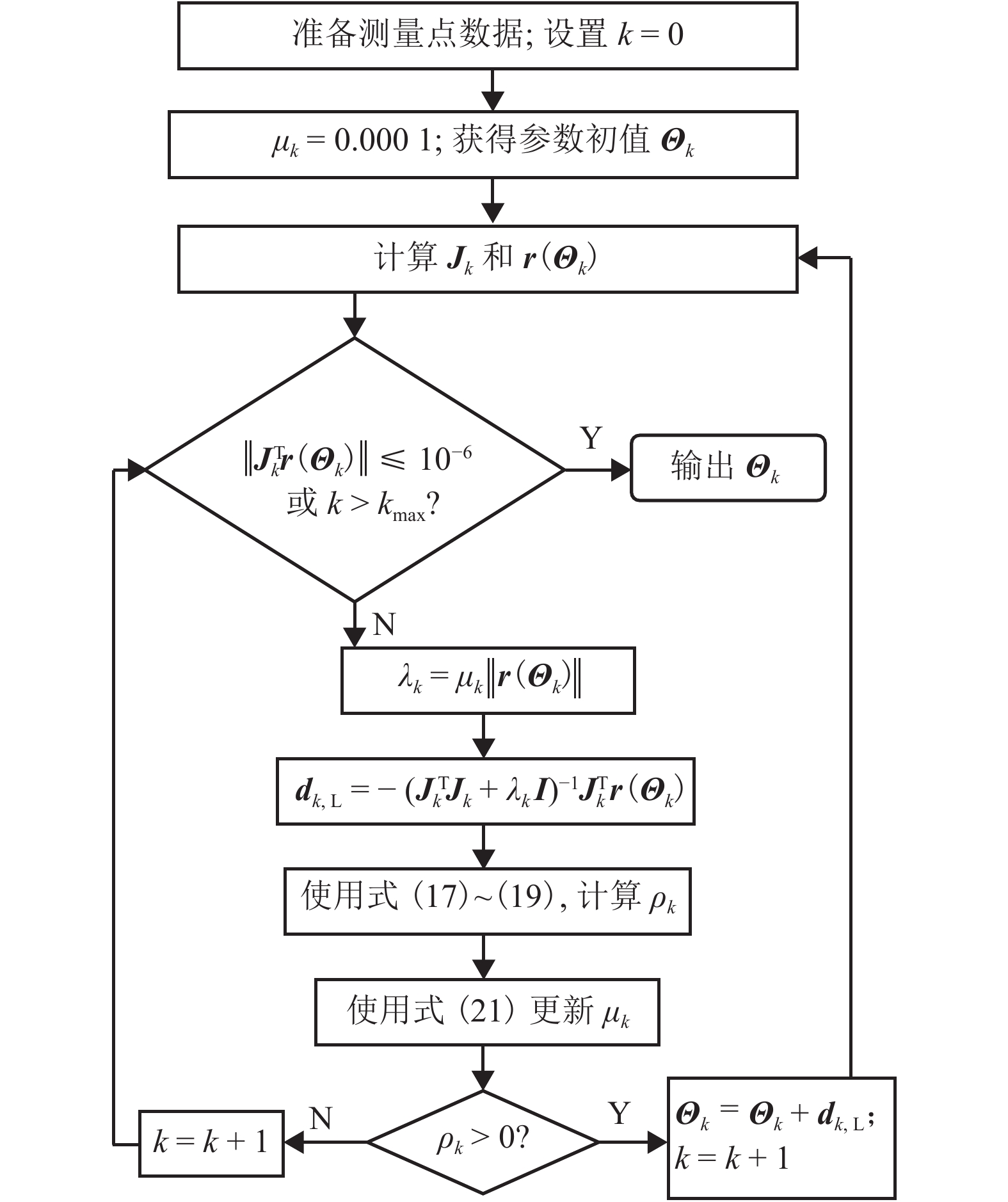Levenberg-Marquardt Algorithm for Orthogonal Fitting of Transition Curves
-
摘要: 为了由测量点识别既有线路中的缓和曲线参数,研究了基于参数方程的缓和曲线正交拟合迭代优化方法. 首先,通过特征值分析,阐明了由于病态性的存在,在迭代过程中,常规的Gauss-Newton (GN)算法会发散. 其次,提出了双目标优化模型,将GN算法与最速下降法结合,确定了正交拟合缓和曲线的Levenberg-Marquardt (LM)算法. 同时提出了在寻优过程中,评估当前迭代位置距离最优位置的远近来动态设置LM参数. 最后以一段缓和曲线的实测点为例,随机取样了5 000例初值,采用蒙特卡罗方法对比了GN算法和LM算法拟合缓合曲线的性能. 试验结果表明:GN算法拟合缓合曲线不收敛;对于不同的初始值,LM算法都收敛到相同的最优值,体现了LM算法具有良好的稳健性;LM算法的迭代次数最少为5次,最大为50次,平均为16.8次,迭代次数和初值与最优值位置的远近相关.
-
关键词:
- 缓和曲线拟合 /
- 正交最小二乘 /
- Levenberg-Marquardt 算法 /
- Gauss-Newton算法 /
- 最速下降法
Abstract: To identify the parameters of transition curves in as-built alignments by measured points, orthogonal least-squares fitting is studied on the basis of the parameter equation of transition curves. First, eigenvalue analysis has clarified that the Gauss-Newton (GN) algorithm usually fails to converge because of the existence of the ill-condition. Next, a bi-objective optimization model is proposed and the Levenberg-Marquardt (LM) algorithm combining the GN algorithm with the steepest descent method is constructed to fit a transition curve to points orthogonally. The LM parameter is updated dynamically during iterations according to the evaluation of the distance between the current and the optimum locations. Finally, Monte Carlo simulations are employed to test the performances of the GN and LM algorithms with measured points and the same 5 000 initial values. Experimental results show that the GN algorithm diverges while the LM algorithm converges to the same optimum under different initial values. The number of iterations, with an average of 16.8 times and the minimum of 5 times and the maximum of 50 times, is related to the distance between the initial and the optimum locations. The LM algorithm shows a better robustness than the GN algorithm. -
表 1 测量点坐标
Table 1. Coordinates of measured points
m 测量点编号 x y 1 865.463 134.175 2 846.063 149.943 3 826.580 165.608 4 807.136 181.321 5 791.543 193.847 6 771.752 209.123 7 759.529 218.475 表 2 Gauss-Newton算法迭代过程中的参数和相应指标
Table 2. Parameters and indexes of Gauss-Newton fitting processes
$k$ xo /m yo /m α/(º) A/m ${\rm{lg}}\;F $ ${\rm{lg}}\left( {\left\| {{{J}}_k^{\rm{T}}{{r}}\left( {{{{\varTheta}} _k}} \right)} \right\|} \right)$ ${\rm{lg}}\left( {\left\| {{{{d}}_{k,\;{\rm{L}}}}} \right\|} \right)$ 0 900.000 100.000 140.249 600.000 2.072 3.537 −∞ 1 735.480 243.913 142.385 108.016 3.980 4.404 2.898 2 879.610 110.057 176.670 26.008 8.952 8.327 2.763 3 802.088 131.635 176.339 −3.367 7.878 8.138 2.520 4 802.088 155.634 179.746 −4.745 9.416 9.523 1.709 5 775.148 160.986 181.215 −3.605 12.229 12.451 1.803 表 3 缓和曲线拟合LM算法性能及参数识别统计结果
Table 3. Statistical results of the LM algorithm performance and parameter identification
E(xo)/m E(yo)/m E(A)/m E(α)/(º) E(k)/次 σ(xo)/mm σ(yo)/mm σ(A)/mm σ(α)/(″) σ(k)/次 838.843 155.731 369.277 140.944 16.8 0.001 0.001 0.007 0.010 9.2 表 4 LM算法迭代过程中的参数和相应指标
Table 4. Parameters and indexes of LM fitting processes
$k$ xo /m yo /m α/(º) A/m ${\rm{lg}}\;F$ ${\rm{lg}}\left( {\left\| {{{J}}_k^{\rm{T}}{{r}}\left( {{{{\varTheta}} _k}} \right)} \right\|} \right)$ $\lg\left( {\left\| { { {{d} }_{k,\;{\rm{L} } } }} \right\|} \right)$ 0 900.000 100.000 140.249 600.00 2.072 3.537 −∞ 1 902.656 103.143 140.258 600.370 −1.216 −1.895 0.618 2 893.401 111.244 140.586 625.124 −1.391 0.825 1.630 3 889.194 114.670 140.635 625.146 −1.519 −0.964 1.186 $\boxed4$ 869.025 131.312 140.810 546.664 −1.291 1.530 2.033 4 886.501 116.895 140.664 617.487 −1.528 −0.081 1.097 $\boxed5$ 866.523 133.349 140.827 534.455 −1.326 1.488 2.044 5 884.137 118.844 140.684 608.059 −1.536 −0.232 1.107 $\boxed6$ 863.879 135.507 140.846 521.855 −1.329 1.474 2.056 6 881.760 120.796 140.703 597.916 −1.546 −0.260 1.126 $\boxed7$ 861.167 137.718 140.865 508.737 −1.326 1.462 2.067 7 879.306 122.812 140.722 587.188 −1.557 −0.255 1.146 $\boxed8$ 858.414 139.961 140.885 495.097 −1.326 1.446 2.078 8 876.759 124.902 140.742 575.845 −1.567 −0.244 1.167 $\boxed9$ 855.641 142.217 140.903 480.977 −1.329 1.425 2.088 9 874.114 127.070 140.762 563.828 −1.582 −0.234 1.188 $\boxed{10}$ 852.880 144.460 140.921 466.465 −1.338 1.396 2.095 10 871.363 129.321 140.782 551.071 −1.597 −0.226 1.211 $\boxed{11}$ 850.172 146.655 140.938 451.716 −1.355 1.356 2.100 11 868.503 131.659 140.803 537.503 −1.615 −0.221 1.234 12 865.534 134.084 140.824 523.060 −1.634 −0.223 1.257 13 862.459 136.591 140.844 507.692 −1.657 −0.233 1.279 14 859.294 139.168 140.865 491.390 −1.684 −0.257 1.301 15 856.090 141.790 140.884 474.232 −1.714 −0.303 1.318 16 852.847 144.407 140.902 456.449 −1.747 −0.389 1.329 17 839.303 155.394 140.971 379.957 −1.767 0.556 1.959 18 839.639 155.090 140.944 374.792 −1.881 −0.781 0.726 19 838.843 155.731 140.944 369.277 −1.882 −7.307 −2.208 -
GIBREEL G M, EASA S M, EL-DIMEERY I A. Prediction of operating speed on three-dimensional highway alignments[J]. Journal of Transportation Engineering, 2001, 127(1): 21-30. doi: 10.1061/(ASCE)0733-947X(2001)127:1(21) BASSANI M, MARINELLI G, PIRAS M. Identification of horizontal circular arc from spatial data sources[J]. Journal of Surveying Engineering, 2016, 142(4): 1-14. 丁克良,欧吉坤,赵春梅. 正交最小二乘法曲线拟合法[J]. 测绘科学,2007,32(3): 18-19. doi: 10.3771/j.issn.1009-2307.2007.03.006DING Keliang, OU Jikun, ZHAO Chunmei. Methods of the least-squares orthogonal distance fitting[J]. Science of Surveying and Mapping, 2007, 32(3): 18-19. doi: 10.3771/j.issn.1009-2307.2007.03.006 丁克良,刘全利,陈翔. 正交距离圆曲线拟合方法[J]. 测绘科学,2008,33(S1): 72-73.DING Keliang, LIU Quanli, CHEN Xiang. Fitting of circles based on orthogonal distance[J]. Science of Surveying and Mapping, 2008, 33(S1): 72-73. AHN S J, RAUH W, WARNECKE H. Least-squares orthogonal distances fitting of circle,sphere,ellipse,hyperbola,and parabola[J]. Pattern Recognition, 2001, 34(12): 2283-2303. doi: 10.1016/S0031-3203(00)00152-7 宋占峰,彭欣,吴清华. 基于中线坐标的地铁调线优化算法[J]. 西南交通大学学报,2014,49(4): 656-661. doi: 10.3969/j.issn.0258-2724.2014.04.015SONG Zhanfeng, PENG Xin, WU Qinghua. Optimization algorithm for horizontal realignment based on coordinate of metro centerline[J]. Journal of Southwest Jiaotong University, 2014, 49(4): 656-661. doi: 10.3969/j.issn.0258-2724.2014.04.015 DONG H, EASA S M, LI J. Approximate extraction of spiralled horizontal curves from satellite imagery[J]. Journal of Surveying Engineering, 2007, 133(1): 36-40. doi: 10.1061/(ASCE)0733-9453(2007)133:1(36) LEVENBERG K. A method for the solution of certain non-linear problems in least squares[J]. Quarterly of Applied Mathematics, 1944, 2(2): 164-168. doi: 10.1090/qam/10666 MARQUARDT D W. An algorithm for least-squares estimation of nonlinear parameters[J]. Journal of the Society for Industrial and Applied Mathematics, 1963, 11(2): 431-441. doi: 10.1137/0111030 ZHAO R, FAN J. On a new updating rule of the Levenberg-Marquardt parameter[J]. Journal of Scientific Computing, 2018, 74(2): 1146-1162. doi: 10.1007/s10915-017-0488-6 SONG Z, DING H, LI J, et al. Circular curve fitting method for field surveying data with correlated noise[J]. Journal of Surveying Engineering, 2018, 144(4): 1-9. FAN J, YUAN Y. On the quadratic convergence of the Levenberg-Marquardt method without nonsingularity assumption[J]. Computing, 2005, 74(1): 23-39. doi: 10.1007/s00607-004-0083-1 -






 下载:
下载:



